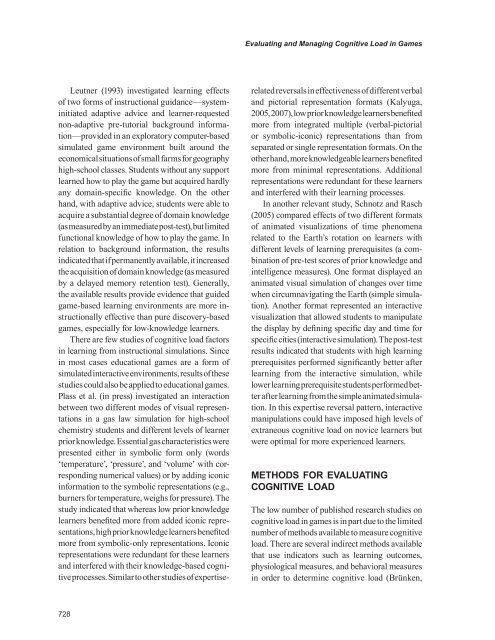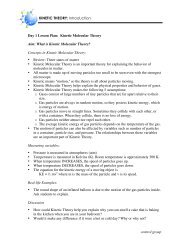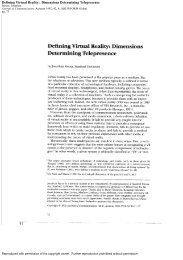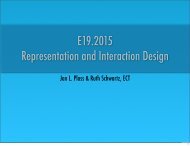Evaluating and managing cognitive load in educational games
Evaluating and managing cognitive load in educational games
Evaluating and managing cognitive load in educational games
You also want an ePaper? Increase the reach of your titles
YUMPU automatically turns print PDFs into web optimized ePapers that Google loves.
<strong>Evaluat<strong>in</strong>g</strong> <strong>and</strong> Manag<strong>in</strong>g Cognitive Load <strong>in</strong> Games<br />
Leutner (1993) <strong>in</strong>vestigated learn<strong>in</strong>g effects<br />
of two forms of <strong>in</strong>structional guidance—system<strong>in</strong>itiated<br />
adaptive advice <strong>and</strong> learner-requested<br />
non-adaptive pre-tutorial background <strong>in</strong>formation—provided<br />
<strong>in</strong> an exploratory computer-based<br />
simulated game environment built around the<br />
economical situations of small farms for geography<br />
high-school classes. Students without any support<br />
learned how to play the game but acquired hardly<br />
any doma<strong>in</strong>-specific knowledge. On the other<br />
h<strong>and</strong>, with adaptive advice, students were able to<br />
acquire a substantial degree of doma<strong>in</strong> knowledge<br />
(as measured by an immediate post-test), but limited<br />
functional knowledge of how to play the game. In<br />
relation to background <strong>in</strong>formation, the results<br />
<strong>in</strong>dicated that if permanently available, it <strong>in</strong>creased<br />
the acquisition of doma<strong>in</strong> knowledge (as measured<br />
by a delayed memory retention test). Generally,<br />
the available results provide evidence that guided<br />
game-based learn<strong>in</strong>g environments are more <strong>in</strong>structionally<br />
effective than pure discovery-based<br />
<strong>games</strong>, especially for low-knowledge learners.<br />
There are few studies of <strong>cognitive</strong> <strong>load</strong> factors<br />
<strong>in</strong> learn<strong>in</strong>g from <strong>in</strong>structional simulations. S<strong>in</strong>ce<br />
<strong>in</strong> most cases <strong>educational</strong> <strong>games</strong> are a form of<br />
simulated <strong>in</strong>teractive environments, results of these<br />
studies could also be applied to <strong>educational</strong> <strong>games</strong>.<br />
Plass et al. (<strong>in</strong> press) <strong>in</strong>vestigated an <strong>in</strong>teraction<br />
between two different modes of visual representations<br />
<strong>in</strong> a gas law simulation for high-school<br />
chemistry students <strong>and</strong> different levels of learner<br />
prior knowledge. Essential gas characteristics were<br />
presented either <strong>in</strong> symbolic form only (words<br />
‘temperature’, ‘pressure’, <strong>and</strong> ‘volume’ with correspond<strong>in</strong>g<br />
numerical values) or by add<strong>in</strong>g iconic<br />
<strong>in</strong>formation to the symbolic representations (e.g.,<br />
burners for temperature, weighs for pressure). The<br />
study <strong>in</strong>dicated that whereas low prior knowledge<br />
learners benefited more from added iconic representations,<br />
high prior knowledge learners benefited<br />
more from symbolic-only representations. Iconic<br />
representations were redundant for these learners<br />
<strong>and</strong> <strong>in</strong>terfered with their knowledge-based <strong>cognitive</strong><br />
processes. Similar to other studies of expertiserelated<br />
reversals <strong>in</strong> effectiveness of different verbal<br />
<strong>and</strong> pictorial representation formats (Kalyuga,<br />
2005, 2007), low prior knowledge learners benefited<br />
more from <strong>in</strong>tegrated multiple (verbal-pictorial<br />
or symbolic-iconic) representations than from<br />
separated or s<strong>in</strong>gle representation formats. On the<br />
other h<strong>and</strong>, more knowledgeable learners benefited<br />
more from m<strong>in</strong>imal representations. Additional<br />
representations were redundant for these learners<br />
<strong>and</strong> <strong>in</strong>terfered with their learn<strong>in</strong>g processes.<br />
In another relevant study, Schnotz <strong>and</strong> Rasch<br />
(2005) compared effects of two different formats<br />
of animated visualizations of time phenomena<br />
related to the Earth’s rotation on learners with<br />
different levels of learn<strong>in</strong>g prerequisites (a comb<strong>in</strong>ation<br />
of pre-test scores of prior knowledge <strong>and</strong><br />
<strong>in</strong>telligence measures). One format displayed an<br />
animated visual simulation of changes over time<br />
when circumnavigat<strong>in</strong>g the Earth (simple simulation).<br />
Another format represented an <strong>in</strong>teractive<br />
visualization that allowed students to manipulate<br />
the display by def<strong>in</strong><strong>in</strong>g specific day <strong>and</strong> time for<br />
specific cities (<strong>in</strong>teractive simulation). The post-test<br />
results <strong>in</strong>dicated that students with high learn<strong>in</strong>g<br />
prerequisites performed significantly better after<br />
learn<strong>in</strong>g from the <strong>in</strong>teractive simulation, while<br />
lower learn<strong>in</strong>g prerequisite students performed better<br />
after learn<strong>in</strong>g from the simple animated simulation.<br />
In this expertise reversal pattern, <strong>in</strong>teractive<br />
manipulations could have imposed high levels of<br />
extraneous <strong>cognitive</strong> <strong>load</strong> on novice learners but<br />
were optimal for more experienced learners.<br />
MEtHODs FOr EVALUAtING<br />
cOGNItIVE LOAD<br />
The low number of published research studies on<br />
<strong>cognitive</strong> <strong>load</strong> <strong>in</strong> <strong>games</strong> is <strong>in</strong> part due to the limited<br />
number of methods available to measure <strong>cognitive</strong><br />
<strong>load</strong>. There are several <strong>in</strong>direct methods available<br />
that use <strong>in</strong>dicators such as learn<strong>in</strong>g outcomes,<br />
physiological measures, <strong>and</strong> behavioral measures<br />
<strong>in</strong> order to determ<strong>in</strong>e <strong>cognitive</strong> <strong>load</strong> (Brünken,<br />
728








